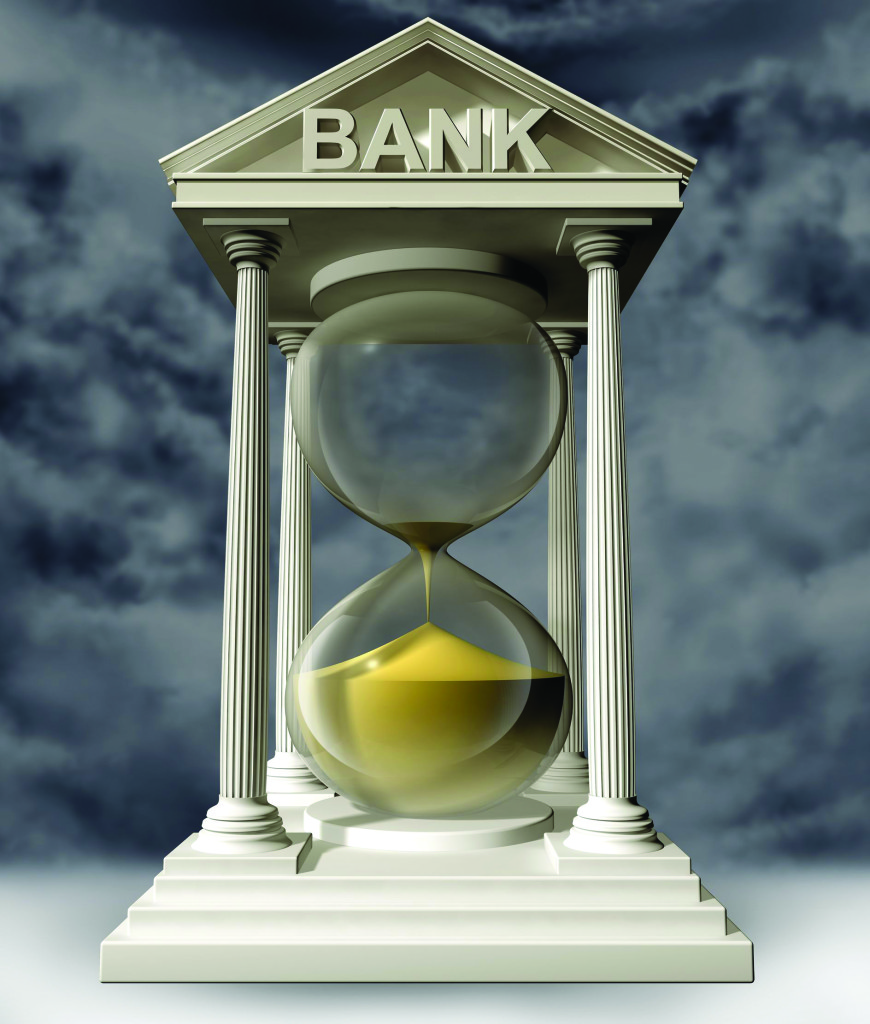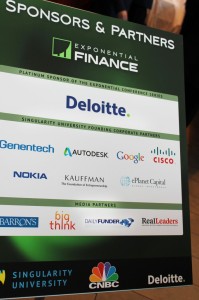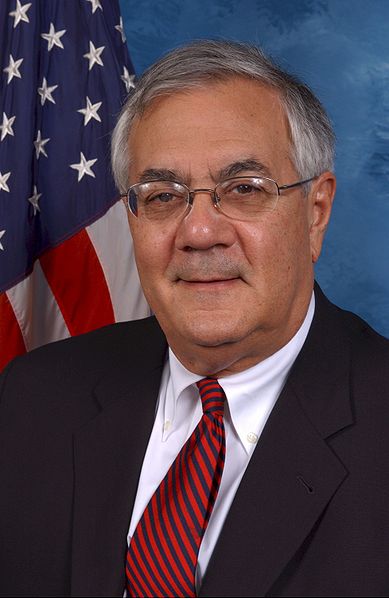Disrupted

Banks and Money take on new meanings in the modern economy
Forty percent of all Fortune 500 companies will be gone in the next 10 years.
Four hundred forty three of the original 500 have already folded.
In 2013, there were only 5,008 U.S. listed public companies, which is only slightly higher than the number there were in 1991 according to the Wall Street Journal. Contrast that against the fact that 2 million corporations are formed in the U.S. each year. But without going public, where exactly are all these businesses going to raise capital? And why are so many corporate leaders expected to fall?
 At the recent Exponential Finance conference presented by Singularity University and CNBC, bright minds from all over the country gathered to teach attendees one general truth, disruption is coming.
At the recent Exponential Finance conference presented by Singularity University and CNBC, bright minds from all over the country gathered to teach attendees one general truth, disruption is coming.
While the breadth of topics varied and at times befuddled my average humanoid brain, (they lost me at the mere mention of Discrete Combinational Optimization Benchmarks), the seeming chaos of alternative lending was put into incredible perspective.
The wider industry is undergoing rapid disintermediation, knowledge is being democratized, and disruptive technologies are growing exponentially.
Luan Cox, the CEO of Crowdnetic and conference panelist, said that real change was already here. For example, she explained that a startup business can go on Indiegogo to raise their initial round of capital while validating their product offering.
From there they can get funding from a peer-to-peer lender or peer-to-business lender. Next, they can land their equity round through equity crowd funders. And following that, they can go back to p2p lenders or take advantage of alternative business lenders such as OnDeck Capital.
That’s an incredible capital raise life cycle. None of these steps require a bank and all of it can be done over the Internet.
Alternative lenders such as these have long considered themselves to be alternatives because banks are the first logical choice. But are they?
Staci Warden, the executive director of the Center for Financial Markets at the Milken Institute summed up the high-risk practice of having a bank account.
“Bank accounts can be frozen, taxed, or confiscated,” Warden said, who was there advocating for digital currencies such as bitcoin.
On the panel she moderated immediately after, it was said that it was even possible to invest in startups using bitcoins. But that makes such transactions, which can sometimes fall under the jurisdiction of state or federal consumer protection laws, harder to keep tabs on.
Who invested in what? Where is the money going? With no central intermediary in bitcoin transactions, you can’t regulate the transfer of the currency itself.
 In a personal interview with Chance Barnett, the founder and CEO of Crowdfunder, he offered his own opinions on regulations. He said that he’d like to see fundraising compliance costs come down.
In a personal interview with Chance Barnett, the founder and CEO of Crowdfunder, he offered his own opinions on regulations. He said that he’d like to see fundraising compliance costs come down.
“Raising $100,000 can cost $35,000,” Barnett said. That’s expensive red tape and it’s easy to imagine how much more popular crowd funding could become if those costs were significantly reduced.
While equity crowd funding might sound like the online version of the age-old lengthy struggle of seeking out investors, he explained that the process can be quite fast, particularly if the company has a prominent lead investor that other people are familiar with. Later, while on a panel, Barnett said “one company raised $600,000 in four hours.”

Crowdfunder also enables startups to raise funds through revenue-based financing, a term that was strikingly close to some of the language being used to describe modern day merchant cash advances.
Since the advent of the ACH repayment method, many merchant cash advance companies have taken the concept of buying future credit card sales and applied it to all gross sales. The advances became revenue-based.
Barnett explained to me that in his definition of revenue-based financing, it is “forward-looking revenue sharing.”
While investors similarly earn a percentage of future revenue, there is nothing like the daily repayment mechanisms put in place as there are in merchant cash advance. Instead, the business is required to submit periodic financial statements to the specific platform, such as Crowdfunder, and then are responsible on their own to deliver payments to the investors.
While “democratizing capital” was an oft-used buzzword of the speakers, even David Weild, the “Father of the JOBS Act” acknowledged in his presentation that investor protection is a bottleneck to freeing up access to capital.
But protection isn’t necessarily an annoyance to be cast aside.
Karen Pascoe, senior vice president at MasterCard Emerging Payments Group made the point that on the bitcoin revolution, there was a lack of chargeback protection. Both the merchant and the consumer have no recourse options.
Even amongst leading technology innovators, there was a healthy fear of swift deregulation.
Jay Sidhu, the chairman and CEO of Customers Bank and Ben Milne, the CEO of Dwolla, both characterized regulators as friends.
“Regulators are regular people,” said Milne. “They’re just trying to do their jobs like everyone else.”
While currencies and access to capital become more disintermediated, it seems that banks are losing their identity. The need for them as a transaction intermediary, account holder, and lender is fading away.
“[Banking] is the most inefficient industry in the world,” Sidhu said. “Banks think innovation is getting a new computer system installed.”
The banking business model changes rapidly and often in a reactionary manner. Every time a new law chokes off their current profit driver, they move to something else. Overdraft fees are one avenue that have been front and center.
In a personal interview with former Congressman Barney Frank, the key author of the Dodd-Frank Wall Street Reform and Consumer Protection Act that was signed into law in 2010, I asked him about disclosures surrounding overdraft fees.
 Many short-term lenders have made the case that measuring the costs of their products with Annual Percentage Rates would not be appropriate specifically because of the limited time span. Since an overdraft fee is essentially a short-term loan, would it make sense to disclose an APR that would potentially register in the thousands?
Many short-term lenders have made the case that measuring the costs of their products with Annual Percentage Rates would not be appropriate specifically because of the limited time span. Since an overdraft fee is essentially a short-term loan, would it make sense to disclose an APR that would potentially register in the thousands?
“Absolutely,” Frank said.
The subject of overdraft fees ignited him and he added that consumers should be required to opt-in to protection in order to receive it. Today, as explained on the Federal Reserve’s website, bank customers must opt-in if they are to receive overdraft protection on ATM fees or debit card fees, but the “rules do not cover checks or automatic bill payments.”
Frank, who the Wall Street Journal has characterized as a longtime liberal voice on Capitol Hill, took a markedly different stance when I flipped the script and asked about business-to-business transactions.
Frank has long championed consumer rights and protections, most notably through the Dodd-Frank Act, but also by leading passage of the Credit Cardholder’s Bill of Rights statute that limits how credit card companies can charge consumers.
When I asked if he would be in favor of a federal maximum cap on business loan interest rates, he replied with a stern, “no.”
He went on to say that he supported transparency in business loan transactions, such that the borrower should be easily able to identify the terms, but that the premise behind consumer loan protections was that consumers were less sophisticated.
As liberal as Barney Frank may be considered, he explained both to me and earlier on a panel, that he opposed the Durbin Amendment of the Dodd-Frank Act, the addition that placed caps and restrictions on debit card interchange fees.
He specifically disliked the anti-free market approach of such caps. It’s a refreshing perspective from an iconic former lawmarker who took a tough stance on Wall Street and banking practices.
While it was Neil Jacobstein, the Artificial Intelligence & Robotics co-chairman at Singular University that said to me, “humans have traditionally required hand-holding for big financial decisions.” One has to wonder if the new hand is the invisible one envisioned by the philosopher Adam Smith.
Money is being distributed in entirely new ways and on a massively disruptive scale. The new bank is the crowd and the new money is being described as “a distributed database where the order of transactions is agreed upon by everyone.” That’s scientist speak for “money ain’t a thang.”
Businesses follow the money so it’s no wonder why tomorrow’s corporate leaders don’t resemble yesterday’s. Where and how you can access money is changing. Even the concept of money itself is being transformed. It was Satoshi Nakamoto who said, “The root problem with conventional currency is all the trust that’s required to make it work.”
One thing you can trust, is that if 40 percent of today’s Fortune 500 companies are actually gone in the next 10 years, you’ll know exactly why that happened. They were disrupted.
Go to: Previous page | Next page
Go to: | 1 | 2 | 3 | 4 | 5 | 6 | 7 | 8 | 9 | 10 | 11 | 12 | 13 | 14 | 15 | 16 | 17 | 18 | 19 | 20 | 21 | 22



